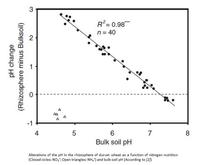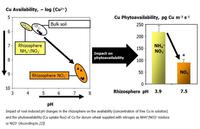pH modifications in the rhizosphere
pH modifications in the rhizosphere are part of the main physico-chemical changes induced by roots that can greatly alter the availability of trace elements. Such pH modifications in the rhizosphere may have numerous causes and notably [1] :
- an imbalance in the uptake of cations and anions by roots, one of the best known causes of which is linked to the type of nitrogen (NO3– or NH4+) taken up by the roots,
- exudation of organic anions into the rhizosphere,
- production of CO2 in the rhizosphere through root respiration and an increase in microbial respiration in response to the exudation of labile organic molecules,
- diffusion of O2 from the root to the rhizosphere in environments under reducing conditions (e.g. rice paddy soil),
- the nutritional status of the plant (P, Fe deficiency, etc.).
Beyond these specific mechanisms, pH modifications induced by roots in the rhizosphere are mainly under the control of [2] :
- the plant itself, since under the same physico-chemical conditions of the soil (notably pH) and with an identical nutritional status, different plant species can acidify or alkalize their rhizosphere,
- the physico-chemical properties of the soil, and notably the pH.
Some of the recent research that has led to a better characterization of pH modifications in the rhizosphere was carried out using the RHIZOtest. The RHIZOtest has also been used to reveal the effect of these changes in pH in the rhizosphere on the availability and phytoavailability of trace elements in soils.
1.
Hinsinger P, Plassard C, Tang Caixian et Jaillard B 2003 Origins of root-mediated pH changes in the rhizosphere and their responses to environmental constraints: A review. Plant Soil, 248, 43-59.
2. Bravin MN, Marti AL, Clairotte M et Hinsinger P 2009 Rhizosphere alkalisation — a major driver of copper bioavailability over a broad pH range in an acidic, copper-contaminated soil. Plant Soil, 318, 257-268.


